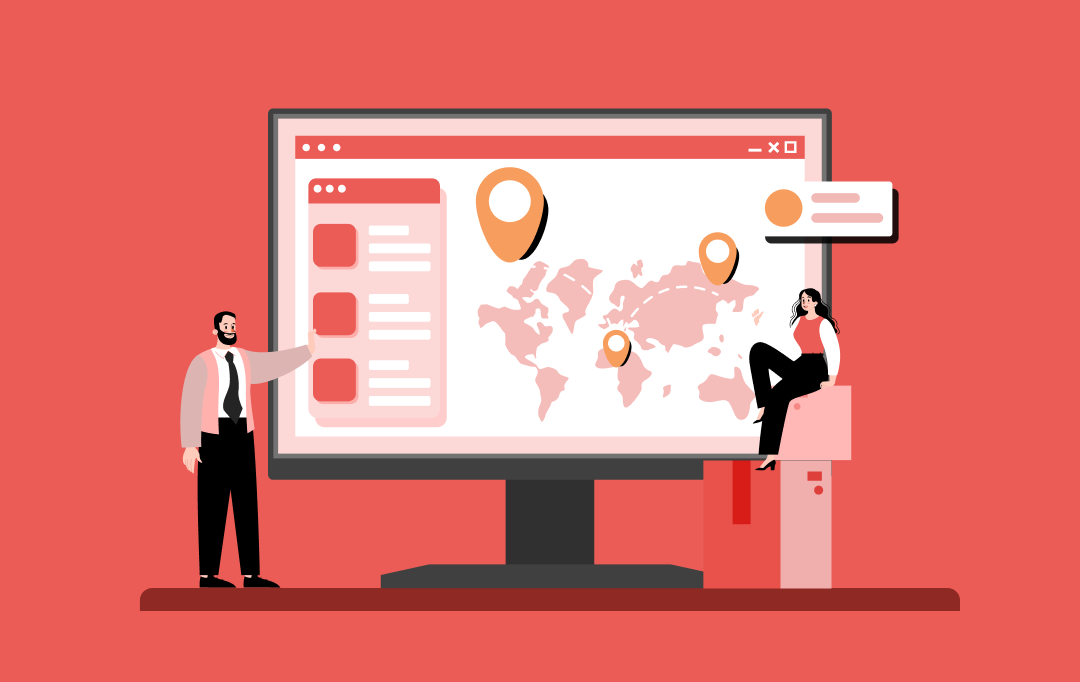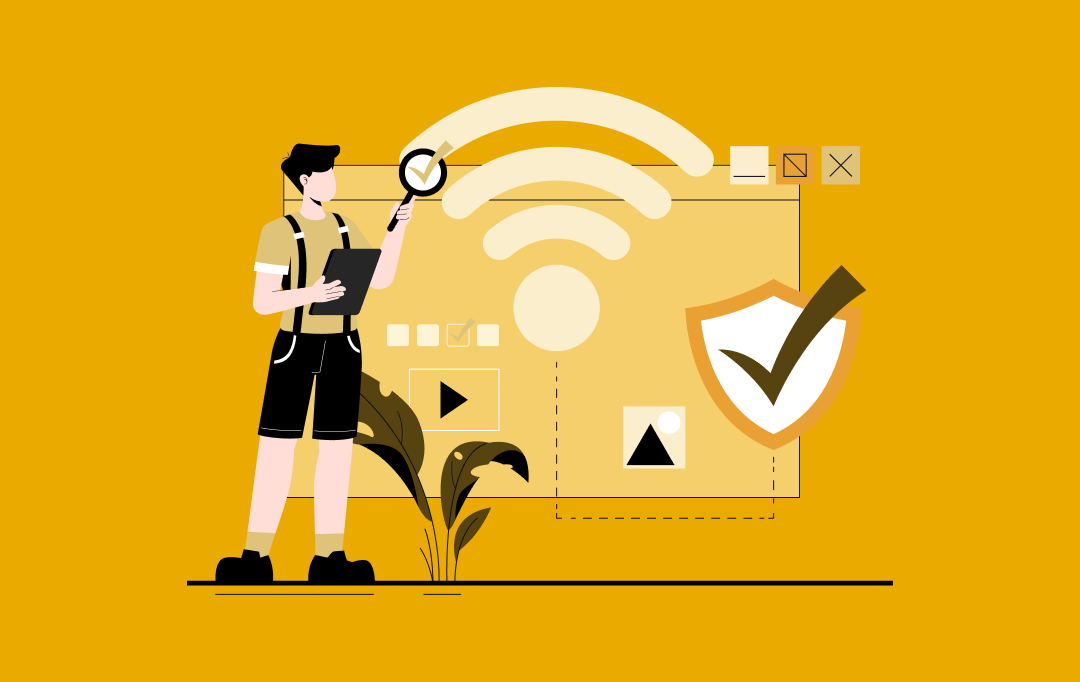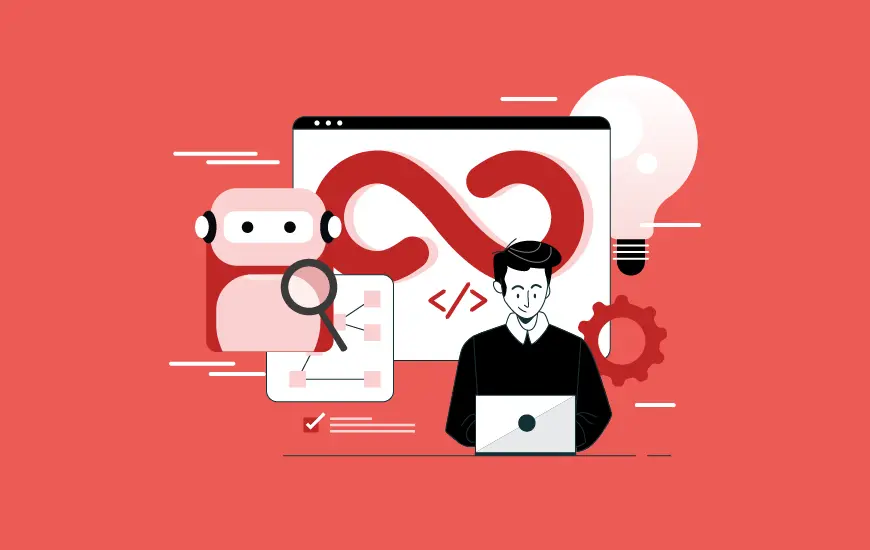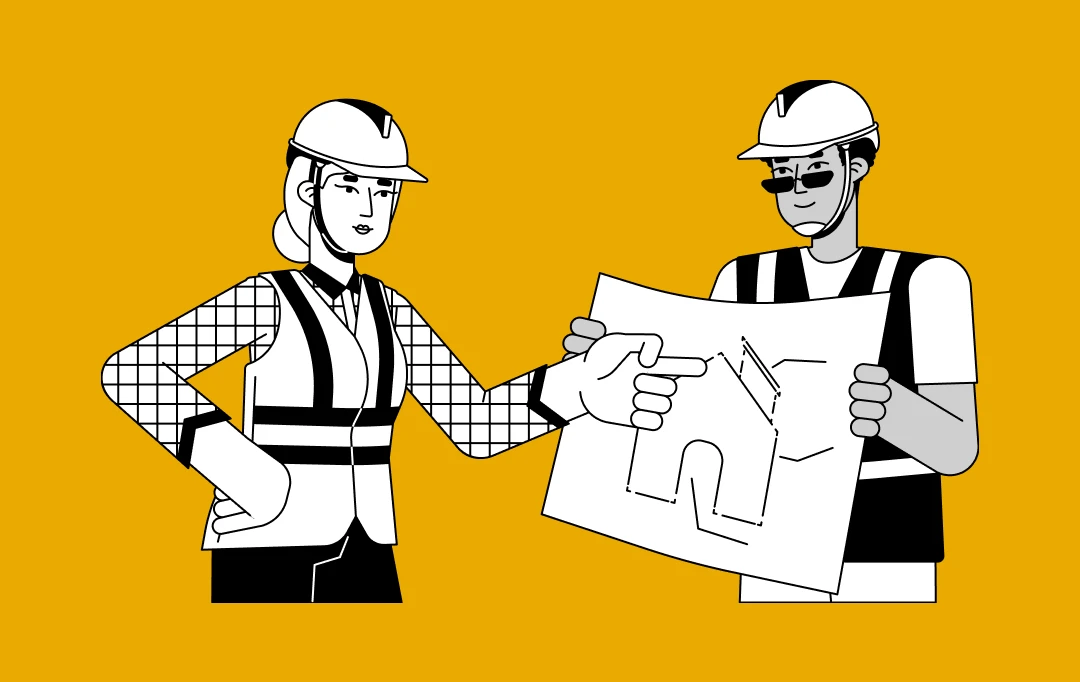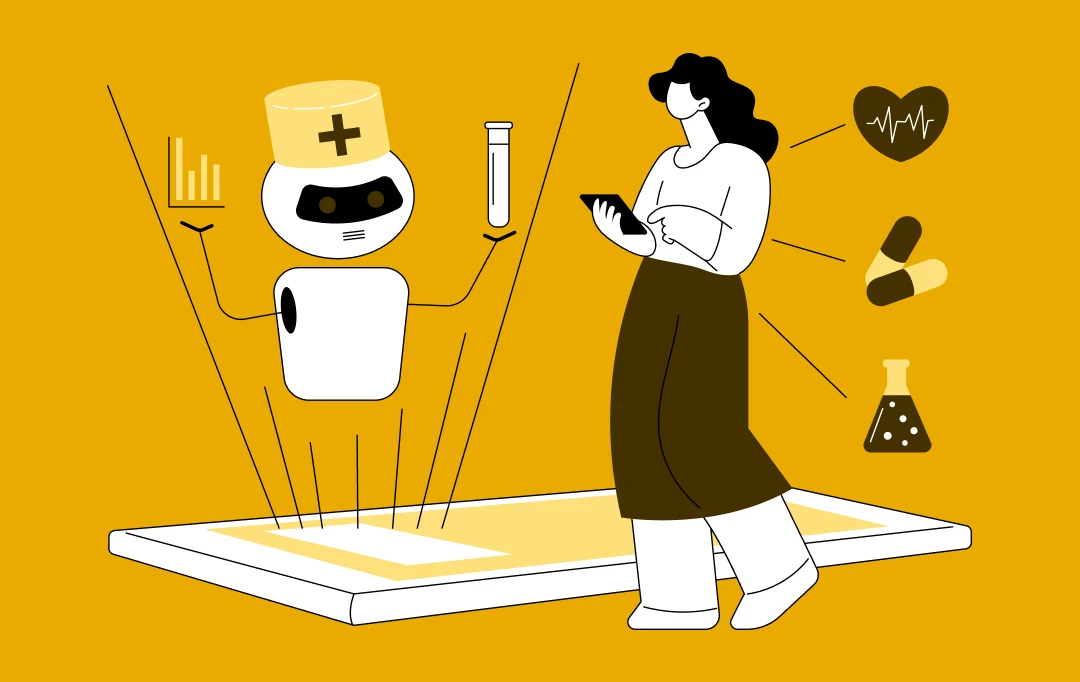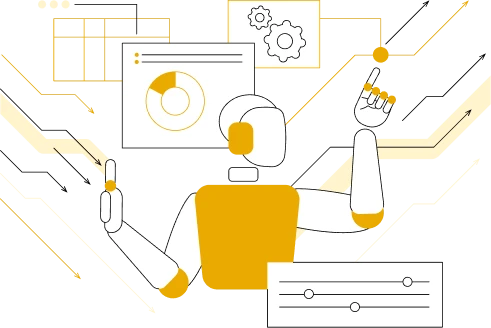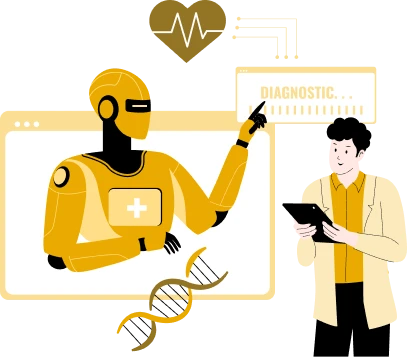- The Challenge: Why Traditional Triage Needs an Upgrade
- Manual Scoring and Subjective Judgement
- Time Pressure and Patient Volume
- Resource Allocation and Clinician Burnout
- The Cost of Inefficiency
- Impact on Patient Outcomes
- AI vs. Traditional Triage Scoring Systems: The Key Differences
- Machine Learning (ML)
- Natural Language Processing (NLP)
- Computer Vision
- Predictive Analytics
- Real-World Use Cases of AI in Triage Systems
- AI in Triage and Emergency Care
- Telehealth and Remote Triage
- Mass Casualty & Crisis Response
- AI During the COVID-19 Pandemic
- Real-World Examples of AI Tools for Hospital Triage
- Yale School of Public Health
- UCSF Health (USA)
- TriageGO
- Anatomy of an AI Triage Platform: The Core Features & Functionalities
- Benefits of AI Traige Systems for Stakeholders
- For Healthcare Systems
- For Clinicians
- Challenges of AI-driven Medical Triage & How to Overcome Them
- Ethical Hurdles: Justice and Fairness
- Transparency and Trust: The "Black Box" Problem
- The Role of the Clinician: Human-in-the-Loop
- Data Privacy and Security
- Integration with Legacy Systems
- Best Practices for Successful Implementation of AI in Triage
- The Future of AI in Triage: The Evolving Landscape of Intelligent Triage
- Explainable AI (XAI) & Transparent Models
- Predictive & Preventive Analytics
- Multi-Modal Fusion & Sensor Networks
- IoT and Wearable Device Integration
- Conversational Front-End Triage
- Federated Learning & Cross-Hospital Networks
- Embedded Clinical Trials & Continuous Learning
- Partner with Appinventiv for AI-Driven Healthcare Innovation
- Some Facts & Figures of Our AI Expertise Because Numbers Don’t Lie
- FAQs
Key takeaways:
- AI in triage systems can reduce wait times and improve prioritization by using core technologies like ML, NLP, and predictive analytics.
- Artificial intelligence in healthcare triage enables smarter allocation of hospital staff and resources by accurately predicting patient severity and hospitalization needs.
- The evolution of AI in triage systems is integrating with wearables and remote data to anticipate healthcare needs before they become emergencies.
- The cost of AI integration in a triage system ranges between $40,000 and $400,000 or more.
Imagine an Emergency Department (ED) at peak capacity: a patient with chest pain arrives, another with mild abdominal cramps waits, and still more line the corridors, anxious and unsettled. At the triage desk, a nurse must swiftly evaluate who needs immediate care and who can wait. The clock is ticking, and every second counts.
No matter how skilled the team, human judgment has limits. Hours of nonstop assessments blur the line between instinct and exhaustion. One wrong call can delay treatment for someone in real danger, while another patient may receive attention that could have waited. It’s a familiar chaos for hospitals everywhere.
Triage is the critical gateway: it determines who gets attention first, sets the path for diagnostic workups, and ultimately influences morbidity and mortality. When misprioritization occurs, patients may deteriorate while waiting, or critical resources may be diverted inefficiently. This brings us to a pivotal question: How do we ensure more accurate, faster, and fairer triage decisions, especially under the most challenging conditions?
The answer lies in AI-driven triage systems. Studies show that AI in triage systems can meaningfully enhance throughput and decision quality in EDs. These systems equip clinicians with predictive insights to enhance accuracy, accelerate critical decisions, and ultimately reshape patient outcomes from the moment they enter the healthcare system.
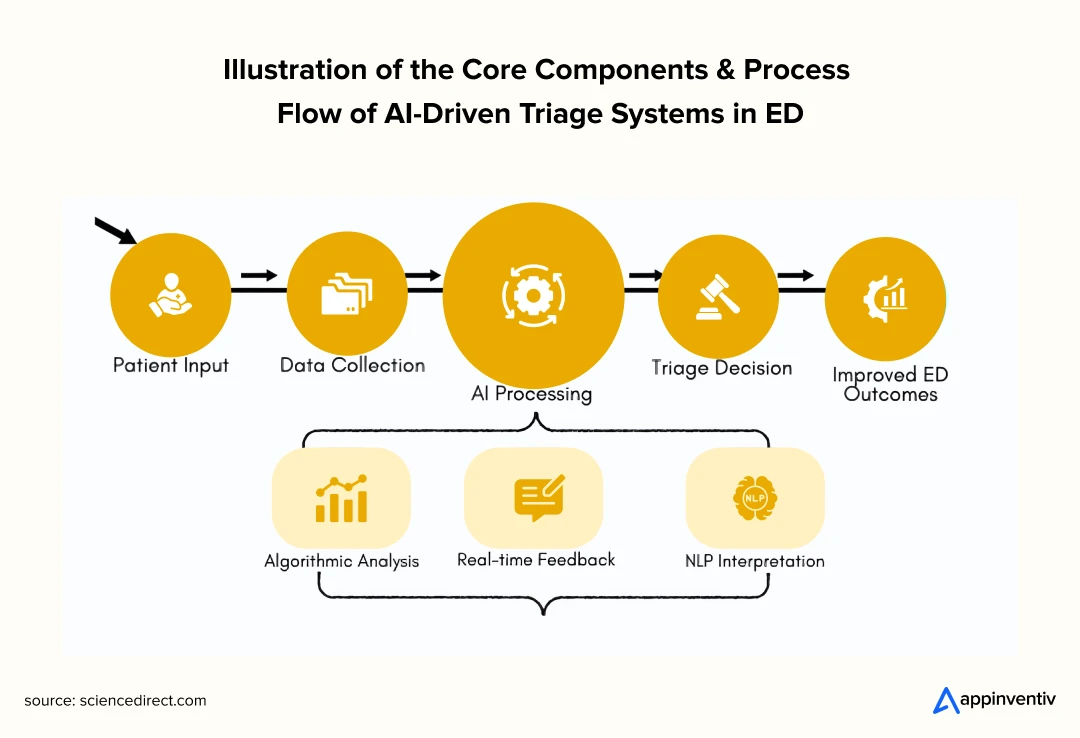
Rather than replacing human judgment, Artificial Intelligence in triage systems augments clinical decision-making with pattern recognition capabilities that process thousands of data points instantaneously. Machine learning algorithms trained on millions of patient encounters can identify subtle indicators that even experienced clinicians might overlook during peak hours.
In this blog, we will dissect the anatomy of AI’s intervention in clinical triage. We will explore the technologies powering this transformation, examine real-world applications demonstrating its impact, confront the ethical and implementation hurdles, and chart a course for the future of AI driven triage in emergency care.
Studies show AI can improve triage accuracy by up to 82%. Let’s discuss how we can implement this at your hospital.
The Challenge: Why Traditional Triage Needs an Upgrade
For decades, triage has been guided by standardized scoring models like the Emergency Severity Index (ESI) in the US or the Manchester Triage System (MTS) in the UK. These frameworks provide a crucial, structured approach to categorizing patient acuity. They rely on a clinician’s ability to rapidly synthesize chief complaints, vital signs, and visual assessments into a priority level.
While indispensable, these systems harbor some inherent vulnerabilities that hamper adoption in the face of modern healthcare demands. The primary pain points of traditional triage systems are:
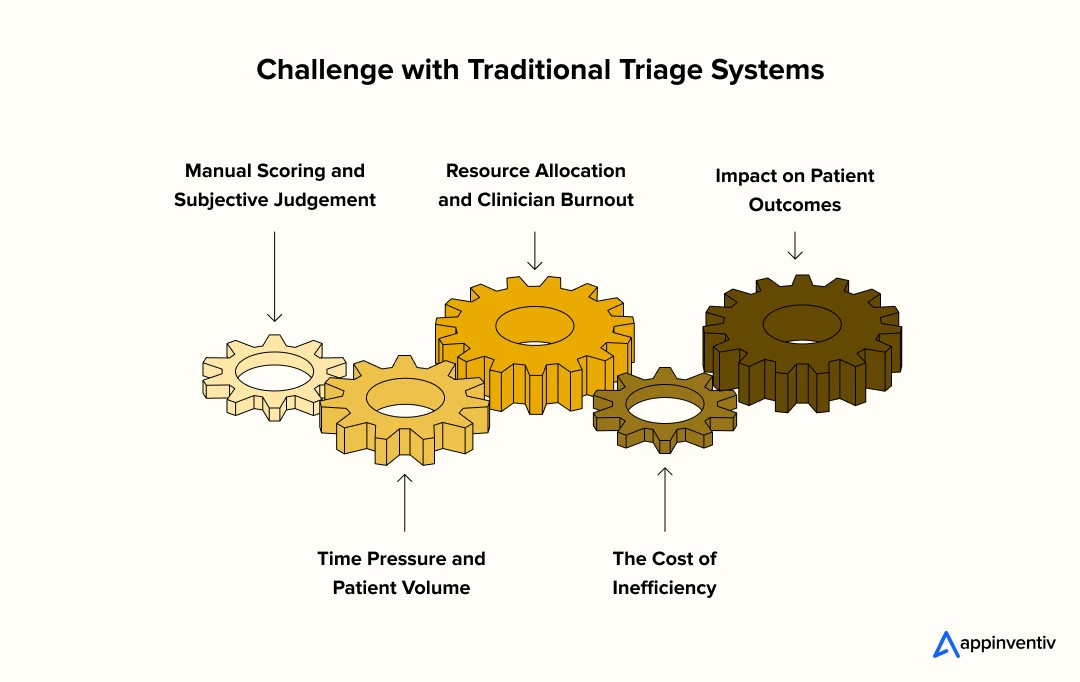
Manual Scoring and Subjective Judgement
Triage still relies heavily on human judgment in many hospitals, and that’s a double-edged sword. A nurse’s decision about priority can differ significantly from another’s, even when they’re looking at the same symptoms.
For example, in the Emergency Severity Index (ESI) system, one clinician might interpret a set of symptoms as needing urgent care, while another might deem the same symptoms low priority. That inconsistency introduces risk: a patient who should be seen quickly could be delayed, or worse, someone with a less critical condition can be rushed through.
Time Pressure and Patient Volume
In triage, every second counts. But when decisions are made under pressure, sometimes with a room full of patients waiting, it’s easy to miss key details. During flu season or mass casualty events, the stakes are higher. Clinicians are making snap judgments without all the information they need, and that’s a setup for errors. It’s a classic case where high pressure leads to avoidable mistakes.
Resource Allocation and Clinician Burnout
Triage isn’t just about deciding who gets care first; it’s about managing the limited resources available. With so many patients to see and scarcity of limited staff, it is intimidating to make a balance.
The pressure of making these fast decisions, day in and day out, naturally leads to clinician burnout. This exhaustion doesn’t just affect the well-being of staff but also impacts the quality of care.
The Cost of Inefficiency
The real cost of inefficient triage is felt in both dollars and lives. Delays in care, repeated tests, and missed priorities don’t just create frustration; they waste valuable resources. Hospitals often waste more time and money than required when things don’t run smoothly. Streamlining the triage process could save both, and most importantly, allow hospitals to provide timely care to patients who need it.
Impact on Patient Outcomes
The most worrying consequence of poor triage decisions is the direct harm to patients. Imagine a patient with sepsis being classified as low priority. They might wait for hours, with their condition worsening. Those hours could mean the difference between life and death. Incorrect triage can worsen patient outcomes, turning what could be a manageable issue into a fatal one
These challenges create an unavoidable need for an upgrade and scream for AI integration in actions. If you are still unsure how AI triage outpaces the manual triage process, here are the key differences between the two, which will give you good insight and help you make an informed decision.
AI vs. Traditional Triage Scoring Systems: The Key Differences
Traditional triage methods such as ESI and NEWS depend on manual judgment and fixed scoring rules. They’ve long guided emergency care, yet their accuracy and speed are limited by human variation and the inability to read complex data in real time.
AI-driven triage works differently. It uses advanced models to read a wider mix of data: vital signs, lab values, patient records, and even small behavioral cues. The system spots links and patterns faster than manual scoring, often improving accuracy, decision time, and overall prediction quality.
The table below highlights how AI-based triage compares with traditional systems in daily hospital settings.
Here is a table outlining the key differences between traditional and AI driven triage systems:
| Metric | Traditional Systems (ESI/NEWS) | AI-Powered Triage |
|---|---|---|
| Accuracy | Moderate, clinician-dependent | High, data-driven |
| Speed | Manual, time-consuming | Instantaneous analysis |
| Outcome Prediction | Limited | Advanced, predictive |
| Consistency | Variable | Consistent, objective |
Recent research highlights the powerful role of AI for improving patient outcomes and triage accuracy. For example, a study by the American College of Surgeons revealed how AI triaged post-operative patients for intensive care with remarkable precision.
The AI system, using 87 clinical variables and 15 specific criteria, triaged 41 out of 50 patients perfectly, with an 82% accuracy rate. The AI was able to predict the need for critical care at a 95% confidence level, outperforming both the ESI and the National Early Warning Score (NEWS).
The AI Augmentation: Engineering Precision into Triage
The impact of artificial intelligence in healthcare triage is about equipping clinicians with a co-pilot capable of processing vast datasets in milliseconds, identifying subtle patterns invisible to the human eye, and providing data-driven recommendations that sharpen clinical judgment. It simply means that the role of AI in medical triage is a powerful augmentation, achieved through a symphony of advanced technologies. The technologies driving this are simple but powerful:
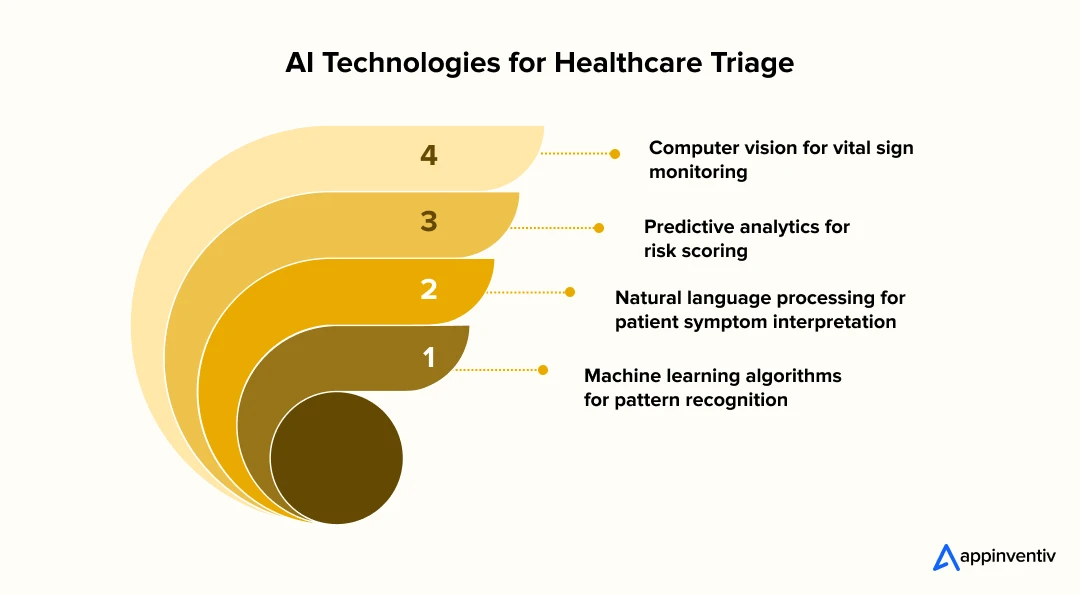
Machine Learning (ML)
ML algorithms in healthcare are the predictive engine. Trained on millions of historical patient records, these models can predict the likelihood of critical events like septic shock, cardiac arrest, or the need for ICU admission with remarkable accuracy. The impact of ML and artificial intelligence–based triage decision support hinges on the predictive power of these finely tuned algorithms.
Natural Language Processing (NLP)
When patients describe what’s wrong, valuable clues hide in their words. NLP in healthcare triage grabs key details that might get missed in quick conversations, helping systems figure out what actually matters. It’s a safety net snagging tiny details humans occasionally overlook when rushed. This is the technology that powers the most effective AI-powered chatbots for healthcare triage.
Computer Vision
AI technologies can analyze video feeds to reveal crucial information. Computer vision algorithms in healthcare triage systems pick up things like heart rate or facial expressions indicating distress, particularly valuable in telehealth when you can’t do physical exams.
Predictive Analytics
This pulls together everything: symptoms, test results, and even how patients present themselves, then generates risk scores. Predictive analytics in healthcare doesn’t overrule human judgment, but supplies data helping doctors decide faster and with better accuracy. This is a core component of effective AI in medical triage for hospitals.
By weaving these technologies together, Artificial Intelligence in triage systems introduces a level of precision, speed, and consistency that manual processes simply cannot match.
Real-World Use Cases of AI in Triage Systems
AI triage isn’t a theory anymore. It’s working quietly in hospitals, clinics, and even remote telehealth rooms. From crowded ERs to global crises like COVID-19, these systems help doctors see patterns faster, move patients sooner, and stretch limited staff without losing accuracy. Here are some of the real world applications of artificial intelligence in triage during emergencies:
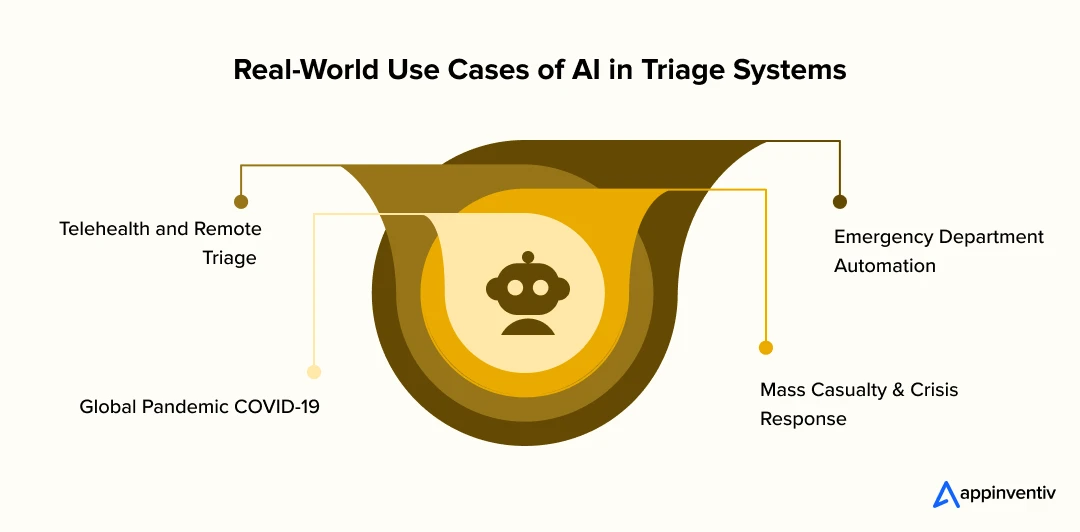
AI in Triage and Emergency Care
In emergency units, every minute is pressure. AI tools now read vitals and patient history together, ranking cases by risk before a nurse even finishes intake. It means fewer missed red flags and shorter waits for those who need care the most.
Telehealth and Remote Triage
AI tools now handle the first step in many telehealth visits. They ask quick questions, note symptoms, and judge how urgent a case might be. Patients needing fast care get connected sooner, while routine cases are queued for later. This helps doctors focus where they’re needed most and gives patients answers within minutes instead of hours.
Also Read: AI in Telemedicine: Use Cases, Challenges & Future Trends
Mass Casualty & Crisis Response
When disaster hits, human coordination alone can choke under scale. AI systems filter live data from field teams, injury logs, and vitals to sort patients fast. The goal is simple: get scarce resources to those who can’t wait. It’s not perfect, but it saves time that often saves lives.
AI During the COVID-19 Pandemic
During COVID-19, hospitals turned to AI to ease the overload. These systems sorted patients by risk, tracked available beds, and flagged who could be treated remotely. It reduced pressure on emergency units and helped staff manage care more efficiently when every resource was stretched thin.
Real-World Examples of AI Tools for Hospital Triage
Healthcare systems have seen significant improvements by weaving AI-powered triage into their operations. For example:
Yale School of Public Health
Yale School of Public Health has rolled out an AI-powered triage system to aid in future Viral outbreak responses. Yale’s AI triage platform manages patient flow during crazy-busy periods by automatically sorting patients based on medical needs and urgency. The researchers built the platform using COVID-19 as a disease model and the platform earned praise for handling high volumes while lifting the administrative burden off clinicians.
Being able to predict which patients can be sent home and those possibly needing intensive care unit admission is critical for health officials seeking to optimize patient health outcomes and use hospital resources most efficiently during an outbreak.
Sr. Professor, Yale School of Public Health.
UCSF Health (USA)
UCSF implemented an AI model digging through EHR data to predict which ED patients will most likely get admitted. This lets care teams start the admission process and bed-hunting earlier, dramatically cutting ED boarding times and improving overall patient throughput.
TriageGO
The TriageGO platform shows how artificial intelligence tackles the complexity of initial patient contact. Using sophisticated natural language processing, the system runs conversational assessments gathering symptom details, medical history, and relevant context. It then generates severity scores and recommendations while documenting the entire encounter for clinician review.
Anatomy of an AI Triage Platform: The Core Features & Functionalities
Modern AI tools for hospital triage comprise several integrated components working as cohesive systems. Here are some of the key features of AI triage platforms:
| Component | Function | Key Considerations |
|---|---|---|
| Clinical Decision Support (CDS) | Presents risk assessments, alerts, and prioritized recommendations | Must be evidence-based, continuously updated, and validated |
| Severity Prediction Engine | Scores each patient’s immediate risk (e.g., deterioration, ICU need) | Threshold calibration and re-scoring on new data |
| Hospitalization / Admission Estimator | Forecasts probability and timing of admission | Enables downstream resource planning |
| Prioritization & Queue Manager | Dynamically ranks waiting patients | Needs low-latency reordering upon new inputs |
| Natural Language Module | Parses symptom descriptions, histories, clinical notes | Domain-tuned NLP with medical vocabulary |
| Data Fusion / Feature Engine | Aggregates structured (vitals, labs) + unstructured data | Handles missingness, outlier handling, normalization |
| User Interface / Dashboard | For triage nurse, ED lead, and downstream teams | Intuitive visualization, alerting, explainability |
| EHR / HIS / Telehealth Integration Layer | Ingests and writes to hospital systems | Interoperability, HL7/FHIR support, secure APIs |
| Audit and Logging | Tracks recommendations, overrides, outcomes | Essential for accountability, safety, regulatory review |
Benefits of AI Traige Systems for Stakeholders
AI triage systems reshape healthcare delivery by backing clinicians, lifting patient experiences, and fine-tuning system-wide operations. Here’s how different stakeholders in the healthcare industry can benefit from AI in emergency triage
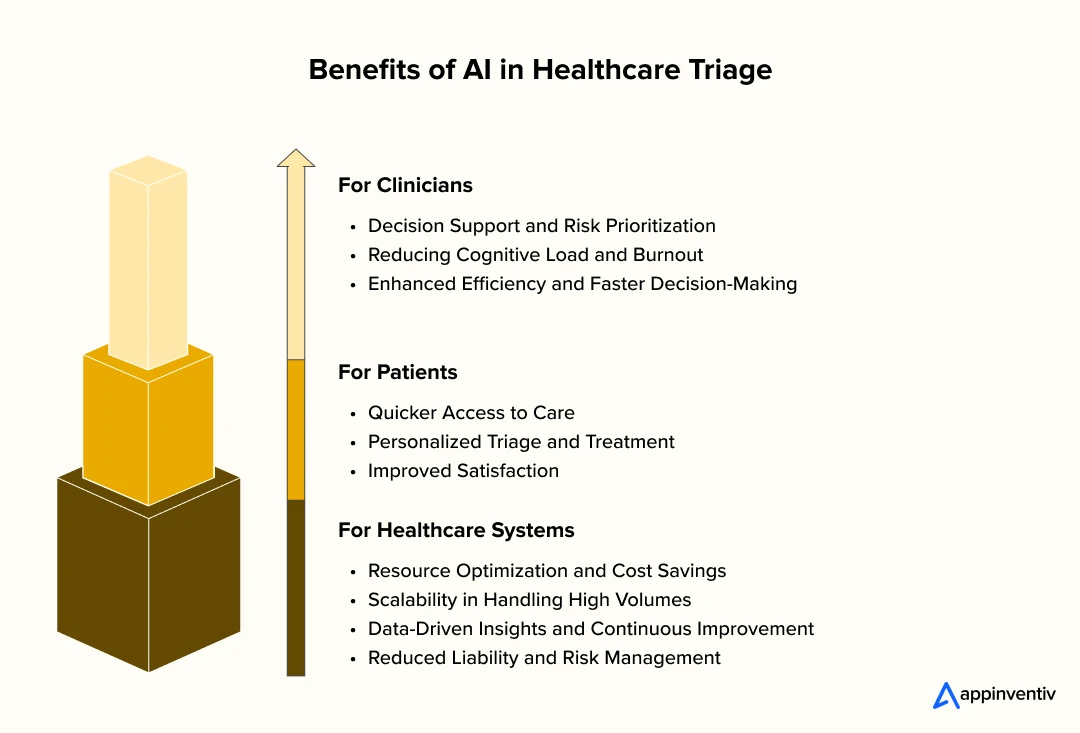 For Patients
For Patients
For patients, AI triage often feels invisible but makes a real difference. The process moves faster, care feels more personal, and waiting rooms grow less chaotic.
Patient gains include:
- Faster attention for urgent cases, cutting long waiting hours.
- Personalized triage based on a person’s history, symptoms, and vitals.
- More precise assessments that shorten diagnosis time and improve satisfaction.
For Healthcare Systems
AI triage doesn’t just improve patient flow; it changes how hospitals run. It cuts waste, saves money, and helps teams plan ahead instead of reacting late.
Key benefits include:
- Smarter use of staff and supplies, lowering unnecessary costs and repeat testing.
- Ability to scale fast when patient numbers spike during flu surges or health crises.
- Rich analytics that show patterns and gaps, helping leaders refine workflows.
- Fewer diagnostic errors and stronger safety records, which also reduce legal exposure.
For Clinicians
AI works like a second set of eyes for doctors and nurses. It reads data, spots patterns, and flags risk levels in seconds, giving clinicians a clearer sense of urgency and direction.
How it helps:
- Ranks patients by urgency using live data, cutting out much of the guesswork.
- Handles routine evaluations so clinicians can focus on the complex, demanding cases.
- Processes information faster than manual triage, leading to better, quicker decisions.
In essence, AI gives clinicians more confidence in their decisions by acting as an intelligent support system, enabling better patient outcomes.
Challenges of AI-driven Medical Triage & How to Overcome Them
While AI in triage systems offers undeniable advantages, it’s not without its challenges. From ethical concerns to technical barriers, deploying AI in healthcare requires careful consideration. Let’s break down these challenges and explore how they can be overcome to unlock the full potential of AI in triage.
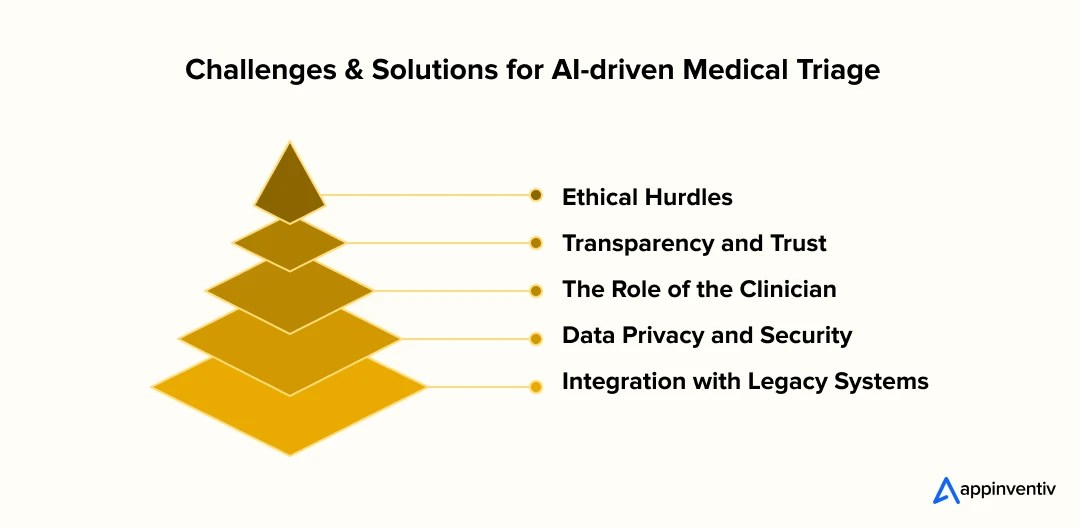
Ethical Hurdles: Justice and Fairness
AI in healthcare hits a big snag with algorithmic bias. Models train on historical data, and this data often carries societal biases tied to race, gender, socioeconomic status, and more. AI might accidentally play favorites with certain groups, creating unfair triage decisions.
How to Overcome It
Cutting bias means grabbing diverse and representative data for training. Healthcare organizations gotta partner with AI developers building fairer models. Regular check-ups and feedback loops catch biases and polish AI systems over time, making sure everyone gets treated fairly.
Transparency and Trust: The “Black Box” Problem
AI systems often work like a “black box”; they dish out results without showing how they landed on them. In high-stakes situations like triage, this mystery makes clinicians pause, wondering if they should trust what AI’s telling them.
How to Overcome It
Trust builds when AI systems become easier to grasp. Explainable AI (XAI) shows clinicians why certain decisions got made. Teaching clinicians how to read AI outputs and throwing in human oversight at critical moments ensures AI stays a helpful tool, not something scary.
The Role of the Clinician: Human-in-the-Loop
AI’s not here kicking clinicians out, but boosting their decision-making game. If AI systems get too hands-off, human judgment and compassion could vanish, especially when cases get complicated.
How to Overcome It
AI needs to stay in the helper role, not take over from clinicians. Clinicians should always make the final call, especially when decisions need that human gut feeling. AI can dish out data-backed insights, but the human element must stay front and center.
Data Privacy and Security
AI triage systems chew through tons of sensitive patient data, stirring up privacy and security worries. Without foolproof protection, this information could end up exposed and can make you bring in the breaking news of another major data breach.
How to Overcome It
AI systems gotta follow regulations like HIPAA and GDPR. Hospitals need locking down data encryption, access controls, and routine security checks. Patients deserve knowing how their data gets used and having a say in whether AI systems can touch it.
Integration with Legacy Systems
Plugging AI into old hospital systems like EHRs gets messy. Plenty of hospitals still run on ancient platforms, and getting AI-powered triage systems playing nice with them becomes a real headache.
How to Overcome It
The trick is teaming up with a custom healthcare software development company that knows both artificial intelligence and hospital IT systems inside out. Using interoperable standards like FHIR keeps integration smooth. Hospitals should kick things off with pilot programs to identify any issues before scaling up.
Best Practices for Successful Implementation of AI in Triage
Implementing AI in triage systems takes more than plugging in technology. It demands smart planning and careful execution. Healthcare organizations nailing the right approach and best practices can maximize ROI and enhance patients’ survival rates:
- Start with a Defined Problem: Don’t implement AI for AI’s sake. Pick a specific, high-impact problem, like slashing ED wait times for cardiac patients or ramping up sepsis detection rates.
- Ensure Data Readiness: Invest money into a solid data infrastructure. Quality and accessibility of your clinical data are the most valuable assets determining your AI initiative’s success.
- Prioritize Clinical Collaboration: Build the solution with your clinicians, not for them. Getting them involved from day one is crucial for designing a tool that aligns with their workflow and tackles their real-world needs.
- Adopt a Phased Rollout: Kick off with a pilot program in a controlled environment. Track everything, grab feedback, and polish the model before spreading it across the enterprise. This approach helps manage the cost of AI integration in triage system and ensures a smoother adoption curve.
Also Read: AI Product Development Cost – A Comprehensive Guide
The Future of AI in Triage: The Evolving Landscape of Intelligent Triage
The current generation of AI in triage systems is already transformative, but we are only at the beginning of this technological revolution. The future of AI-driven triage in emergency care is poised to be even more integrated, predictive, and personalized, extending far beyond the four walls of the emergency department. The trajectory of innovation points towards several exciting advancements.
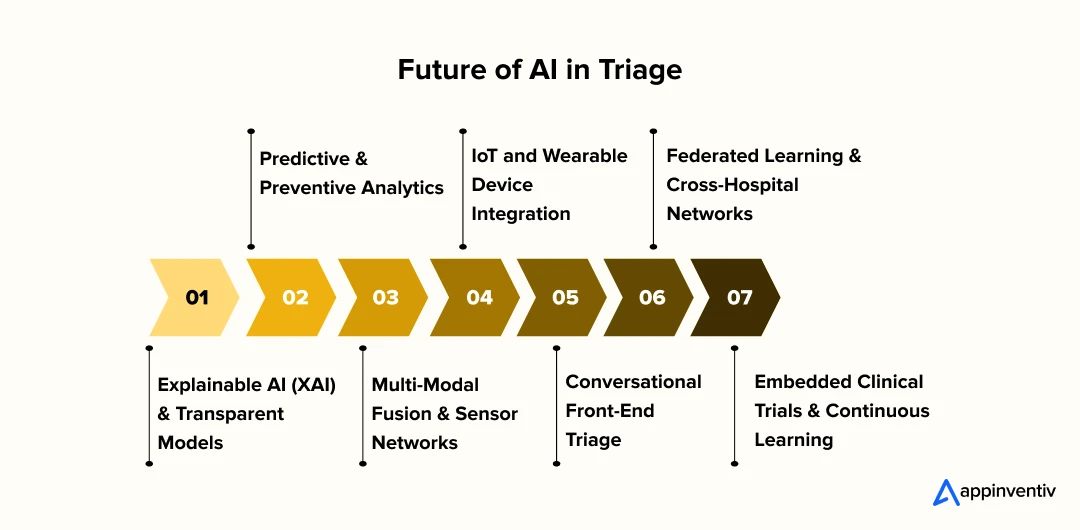
Explainable AI (XAI) & Transparent Models
Next-gen systems will bake interpretability in, not as an afterthought. Transparent architectures like causal models or inherently interpretable structures will reduce skepticism and bolster regulatory acceptance.
Predictive & Preventive Analytics
Beyond reactive triage, systems will nudge toward pre-emergency intervention: flagging at-risk patients days ahead, or triggering outreach before symptoms escalate.
Multi-Modal Fusion & Sensor Networks
Future models will ingest imaging, continuous sensor data (wearables, bedside monitors), voice, and video signals alongside traditional data to refine real-time acuity estimates.
IoT and Wearable Device Integration
Future AI-driven triage systems must focus on seamlessly integrating with wearable technology in healthcare, as this would significantly improve both emergency department (ED) efficiency and patient safety.

Conversational Front-End Triage
LLM-driven dialogue agents (like C-PATH) will engage patients prior to arrival, capture symptom nuances, and even complete preliminary triage routing. This represents a frontier where AI-powered chatbots for healthcare triage become a patient’s first interface.
Federated Learning & Cross-Hospital Networks
To address data privacy and generalization, federated model training across institutions will enable learning shared insights without exposing local patient data.
Embedded Clinical Trials & Continuous Learning
Production systems will host A/B testing of evolving models, monitor drift, and self-improve while preserving human oversight and safety controls.
Contact us to see how AI can optimize your department’s triage system, improve patient outcomes, and reduce operational costs.
Partner with Appinventiv for AI-Driven Healthcare Innovation
At Appinventiv, we specialize in delivering next-gen AI-driven healthcare solutions that improve patient care, streamline operations, and ensure flawless integration with existing hospital systems.
With over 10 years of experience in HealthTech, we have delivered over 3000+ successful projects, including 300+ AI-powered solutions and 500+ digital health platforms. Here are some of our proven projects in the healthcare domain that give a good glimpse of our expertise in building secure and scalable digital healthcare products.
Our portfolio includes:
- Soniphi: We developed a voice-based wellness app for Soniphi that analyzes vocal resonance to assess user vitality. This enables proactive health monitoring.
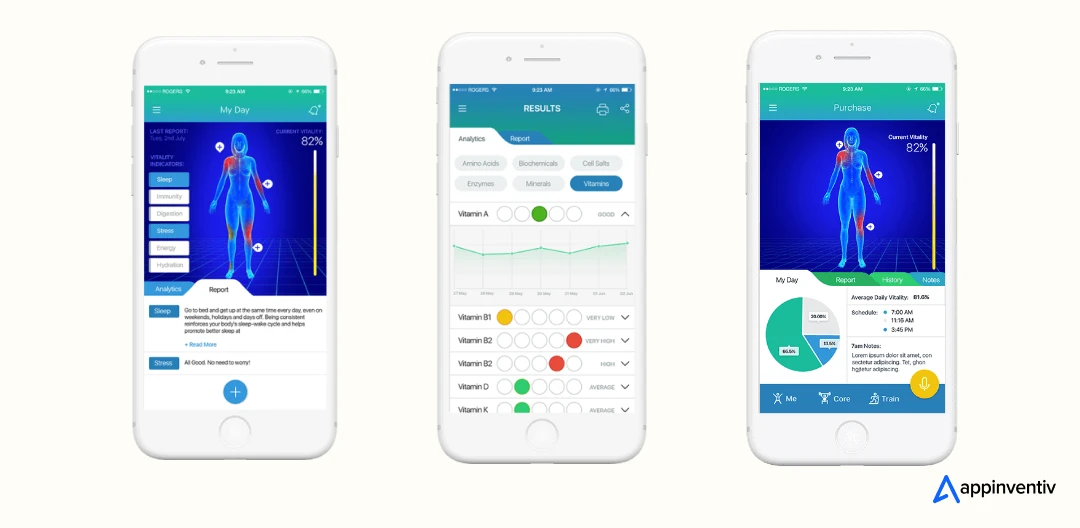
- DiabeticU: We have also built DiabeticU, a diabetes management app that integrates with wearables. This helps users track their glucose levels and manage their well-being proactively.
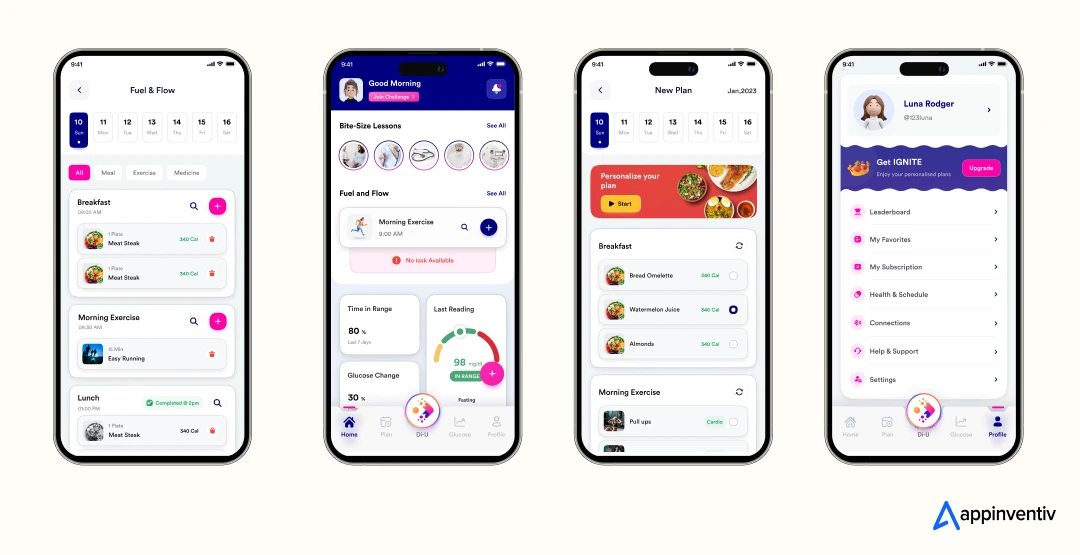
- Health-e-People: Our HealthTech experts created Health-e-People, a health assessment platform that empowers users to monitor their health and connect with caregivers, promoting informed health decisions.
Health-e-People
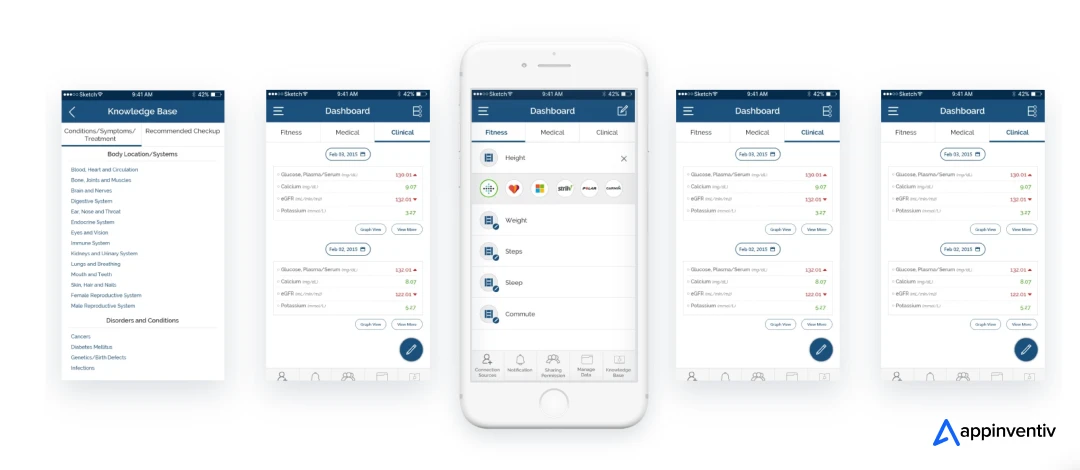
Some Facts & Figures of Our AI Expertise Because Numbers Don’t Lie
Our team of 1600+ tech experts, including 200+ data scientists and AI engineers, has deployed 150+ custom AI models, completed 75+ enterprise AI integrations, and fine-tuned 50+ bespoke LLMs. These are not just the numbers; these are the testament to our AI excellence that ensures the custom AI triage we build is secure, scalable, and tailored to the unique needs of each healthcare client.
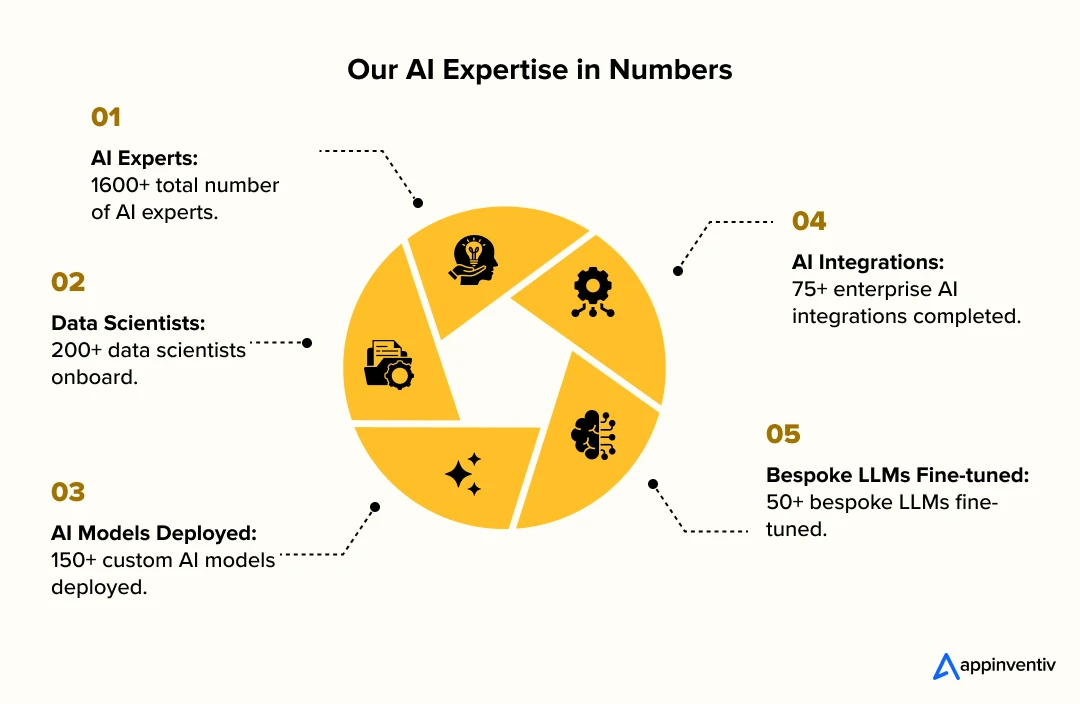
Our End-to-End Healthcare AI Development
Our commitment extends beyond initial deployment. Healthcare environments upgrade constantly: populations shift, clinical protocols update, and new evidence emerges. Keeping this constant change in consideration, we provide end-to-end healthcare product development services even after product launch and deployment. Our ongoing support ensures your AI systems adapt to changing contexts, maintain accuracy, and continue delivering value throughout their operational life.
Whether you are a healthcare system looking to optimize your emergency department, a MedTech startup developing a novel diagnostic tool, or an entrepreneur with a vision for the next generation of telehealth, our suite of AI consulting services can provide the right guidance and technical execution needed to bring your vision to life.
Partner with us now to leverage AI in triage systems.
FAQs
Q. How does AI triage differ from traditional triage systems?
A. AI triage differs from traditional systems by using advanced algorithms and machine learning to analyze patient data and predict risks. While traditional triage depends on clinician judgment and manual processes, AI triage automates and speeds up decision-making by assessing large volumes of data from various sources in real-time.
This leads to more objective, consistent prioritization and reduces human error. AI can handle high patient volumes efficiently, ensuring faster, more accurate triage, and improving patient outcomes compared to the subjective and slower methods of traditional triage.
Q. What is AI triage in healthcare?
A. AI triage in healthcare refers to the use of artificial intelligence to automate and enhance the decision-making process of triaging patients. AI can help prioritize cases based on real-time health data, such as vital signs and symptoms, and direct patients to the appropriate level of care.
Q. How does AI streamline the triage process in healthcare?
A. AI streamlines the triage process in healthcare by the following ways:
- Automates repetitive tasks: AI handles routine assessments, freeing up clinicians for complex cases.
- Speeds up decision-making: AI processes data and generates insights faster than human decision-making.
- Improves accuracy: AI uses data to provide objective and real-time prioritization of patient care.
Q. How can AI improve patient outcomes in hospitals and clinics?
A. Here are some of the most notable ways by which AI in triage systems improves patient outcomes
- AI accelerates patient prioritization, ensuring those who need urgent care are treated first.
- AI identifies patterns that human clinicians may miss.
- By predicting patient deterioration, AI ensures timely interventions.
Q. How is AI transforming emergency care triage systems?
A. AI is transforming emergency care triage by automating the process, offering predictive analytics, and providing real-time data analysis. This leads to quicker patient prioritization, more accurate assessments, and optimized resource allocation, all of which are essential in high-pressure environments like emergency departments.
Q. What types of algorithms are used in AI-based triage systems?
A. Algorithms used in an AI triage system include:
- Decision trees: Help classify patients based on risk factors.
- Random forests: Improve prediction accuracy.
- Support vector machines: Classify patients based on complex data.
- Neural networks: Analyze patterns in vast amounts of data to assess patient needs.
Q. What is the cost of AI integration in triage system?
A. On average, the cost of AI integration in triage system ranges between $40,000 and $400,000 or more.
However, this is just a rough estimate; the actual cost can go up or down, depending on several key components like the project’s complexity, location of the AI development company, platform compatibility, and so on.
If you want to get a more precise estimate tailored to your specific business challenges and goals, discuss your project idea with us.


- In just 2 mins you will get a response
- Your idea is 100% protected by our Non Disclosure Agreement.
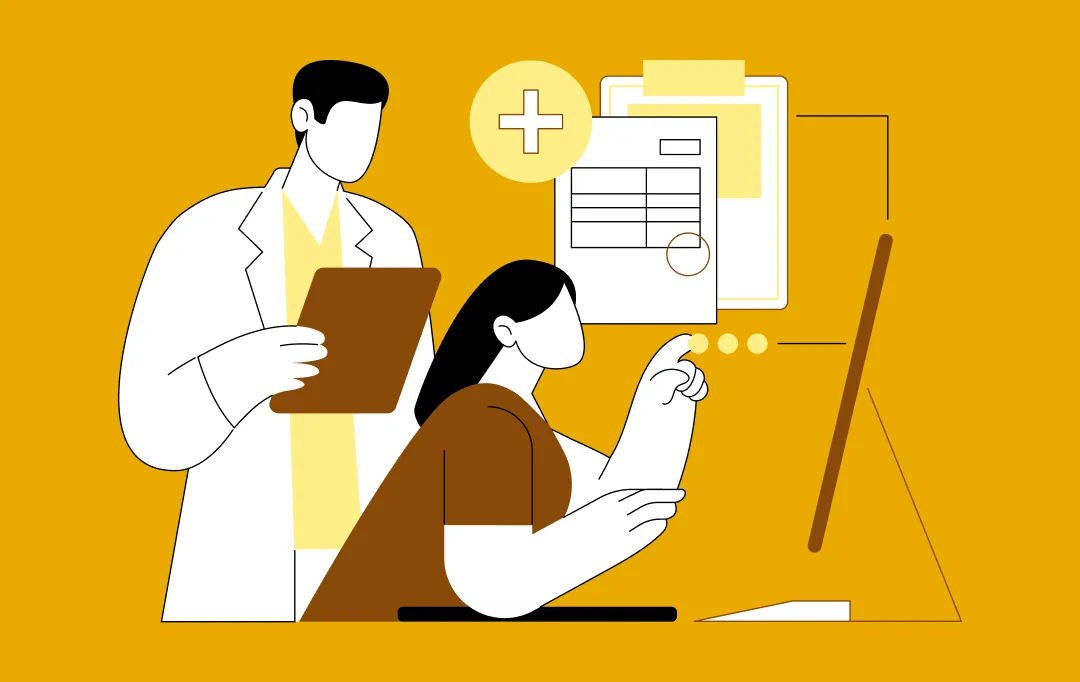
How Much Does It Cost to Build a Healthcare App in Saudi Arabia? All You Need to Know
Key takeaways: Healthcare app costs in Saudi Arabia range from 112,500 SAR to 2,250,000+ SAR based on size and complexity. The type of app you build matters more to cost than anything else. Compliance, security, and scalability are built into the cost, not add-ons. Development and testing consume the largest share of the budget. Hidden…
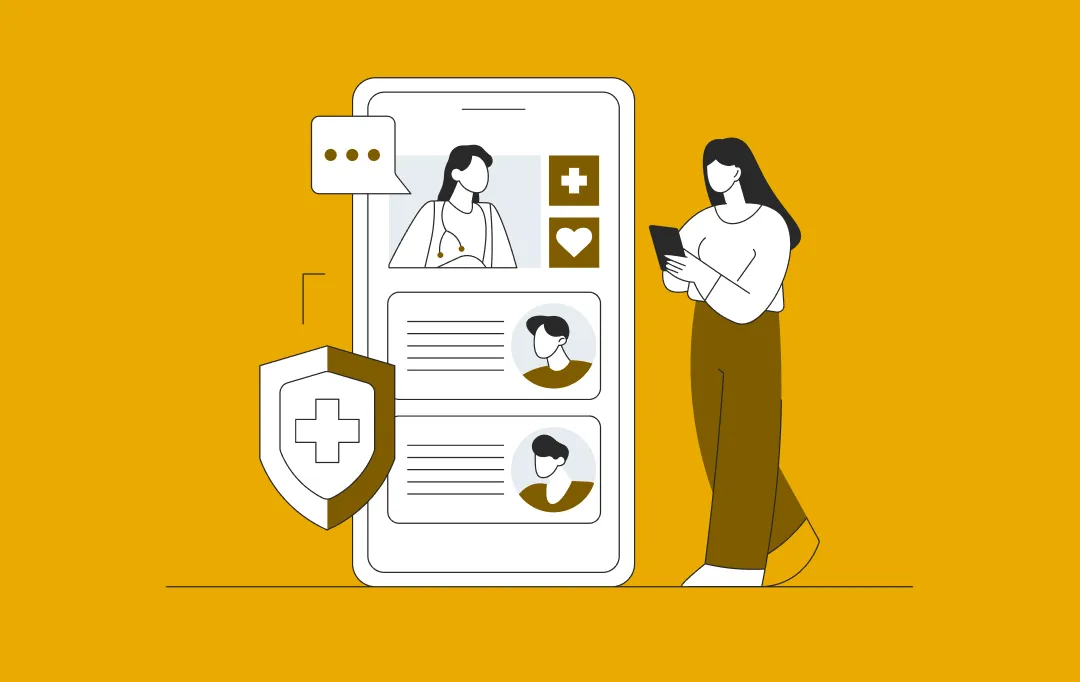
How Prescriptive Analytics Is Shaping the Future of Healthcare Management
A healthcare business doesn’t fall behind because its teams lack skill. It falls behind when decisions take too long. Bed allocation runs on yesterday’s data. Procurement reacts only when shortages hit. Care managers step in after a patient is already at risk. And leadership gets a picture of what’s happening only after the quarter closes,…
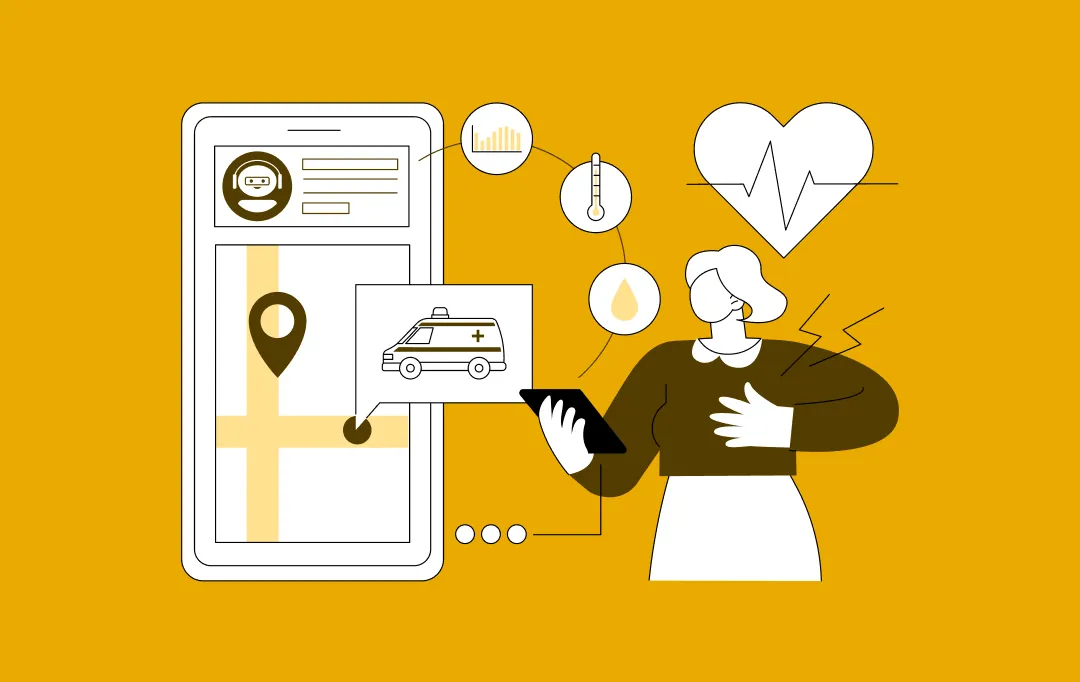
How to Build an Urgent Care App? A Step-by-Step Process, Features and Costs
Key takeaways: With more people turning to digital healthcare, the urgent care app market is expected to touch $3.1 billion by 2024 and continue growing fast through 2030. Apps that offer easy scheduling, video consultations, EHR access, and quick insurance handling tend to attract more users and keep them coming back. Developing an urgent care…











